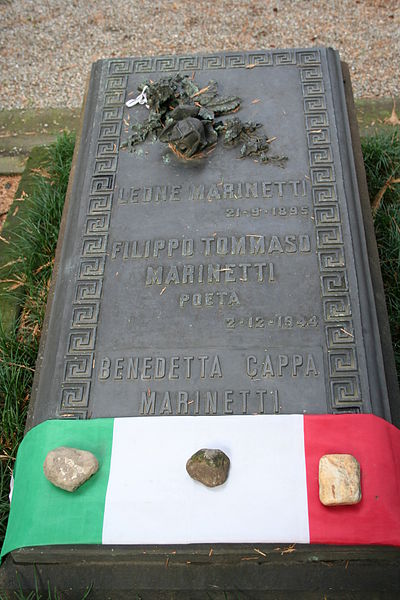Filippo Tommaso Marinetti
Filippo Tommaso Emilio Marinetti was an Italian poet, editor, art theorist, and founder of the Futurist movement. He was associated with the utopian and Symbolist artistic and literary community Abbaye de Créteil between 1907 and 1908. Marinetti is best known as the author of the first Futurist Manifesto, which was written and published in 1909, and as a co-author of the Fascist Manifesto, in 1919.
Filippo Tommaso Marinetti
Poem of Marinetti on a wall in Leiden
Filippo Tommaso Marinetti
Grave of Filippo Tommaso Marinetti and his wife Benedetta Cappa at Monumental Cemetery of Milan (Italy)
Futurism was an artistic and social movement that originated in Italy, and to a lesser extent in other countries, in the early 20th century. It emphasized dynamism, speed, technology, youth, violence, and objects such as the car, the airplane, and the industrial city. Its key figures included Italian artists Filippo Tommaso Marinetti, Umberto Boccioni, Carlo Carrà, Fortunato Depero, Gino Severini, Giacomo Balla, and Luigi Russolo. Italian Futurism glorified modernity and, according to its doctrine, "aimed to liberate Italy from the weight of its past." Important Futurist works included Marinetti's 1909 Manifesto of Futurism, Boccioni's 1913 sculpture Unique Forms of Continuity in Space, Balla's 1913–1914 painting Abstract Speed + Sound, and Russolo's The Art of Noises (1913).
Gino Severini, 1912, Dynamic Hieroglyphic of the Bal Tabarin, oil on canvas with sequins, 161.6 × 156.2 cm (63.6 × 61.5 in.), Museum of Modern Art, New York
Italian futurists Luigi Russolo, Carlo Carrà, Filippo Tommaso Marinetti, Umberto Boccioni and Gino Severini in front of Le Figaro, Paris, February 9, 1912
Umberto Boccioni, Unique Forms of Continuity in Space (1913)
Umberto Boccioni, sketch of The City Rises (1910)








